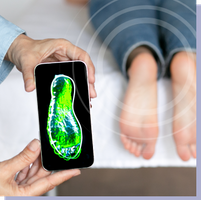Chronic pain is a complex health issue that affects millions of people worldwide. It is important to understand what chronic pain is, its common causes, and how it can affect quality of life. This knowledge can help us deal with chronic pain more effectively.
Chronic pain is defined as any pain that lasts longer than 12 weeks, as opposed to acute pain, which is a normal sensation that warns of possible injury. Chronic pain can last for months or even longer. It can occur anywhere in the body and vary in intensity, frequency, and duration.
Common causes of chronic pain
Chronic pain can be caused by a variety of factors. It often results from an initial injury, such as a back sprain, or an ongoing factor such as an illness. Other common causes include aging, nerve damage, and conditions such as fibromyalgia or arthritis. However, in some cases, it is difficult to determine the cause of chronic pain.
The impact of chronic pain on quality of life
Chronic pain can have a profound impact on a person’s quality of life. It can lead to reduced mobility, lack of energy, changes in appetite, and sleep disturbances. Chronic pain can also affect a person’s emotional well-being, leading to feelings of frustration, depression, and anxiety. It is important to remember that chronic pain is not just a physical condition, but can also have significant psychological and emotional effects.
In the following sections, we will delve deeper into the role of exercise in treating chronic pain, how physical therapy can help, and practical tips for dealing with chronic pain. By understanding chronic pain and its effects, we can take proactive steps to treat and improve our quality of life.
The role of exercise in pain management
Exercise plays a crucial role in treating body pain. It can help reduce pain, improve mobility, and improve overall health. Let’s explore how exercise affects the body, its benefits, and an example of chronic pain relief through regular exercise.
How physical activity affects the body
Exercise stimulates the body in different ways. When you exercise, your body releases chemicals called endorphins. These are the body’s natural painkillers, and they can help reduce pain. Exercise also improves blood flow, which can help nourish the body’s cells and remove waste products. Regular exercise can also strengthen muscles, which can help prevent injuries and reduce pain.
Benefits of exercise in treating pain
Exercise can offer several benefits in dealing with pain. Regular exercise can help reduce chronic pain and can improve your flexibility and strength. This can make it easier to perform daily activities. Exercise can also help you maintain a healthy weight, which can reduce stress on your joints and help prevent pain. In addition, exercise can boost your mood and help you sleep better, which can also help.
Case study: Alleviating chronic pain through regular physical activity
Consider the case of my father, a 45-year-old man who suffers from chronic back pain. My father began a regular exercise routine that included walking, swimming, and light weight lifting. After six months, my father reported a significant decrease in his back pain. He also noticed improvements in his mood and sleep. This case illustrates how regular exercise can help with chronic pain.
In conclusion, exercise plays a vital role in pain management. It can help reduce pain, improve physical function, and improve overall health. So, if you are dealing with body pain, consider incorporating regular exercise into your routine. It is important to consult a professional before starting any new exercise program.
Physical Therapy for Pain Management: An Overview
Physiotherapy is a powerful tool, a non-invasive approach that can help you regain control of your body and significantly reduce your pain. In this section, we will explore what physiotherapy is, how it helps treat chronic pain, and provide examples of physiotherapy exercises for pain relief.
What is physiotherapy?
Physiotherapy, a health profession that focuses on the diagnosis, treatment, and prevention of disease through physical means. It involves the use of therapeutic exercises, manual therapy techniques, and various modalities such as heat, cold, and electricity to help patients improve their physical function and overall quality of life.
How physical therapy helps treat chronic pain
Physical therapy plays a crucial role in treatment. It helps reduce pain and inflammation, increase mobility, improve strength and flexibility, and promote overall health. Physical therapists use a variety of techniques to help manage pain. According to a study, 92% of patients reported improved physical function after undergoing physical therapy for chronic pain.
Examples of physical therapy exercises for pain relief
There are many physical therapy exercises that can help relieve pain. These exercises are designed to strengthen muscles, improve flexibility, and increase range of motion. Here are a few examples:
Stretching exercises: These exercises help improve flexibility and reduce muscle tension, which can help relieve pain.
Strengthening exercises: These exercises help build strength in the muscles that support painful joints, reducing the load on those joints and relieving pain.
Aerobic exercises: These exercises, such as walking, swimming, or cycling, can help improve overall fitness and well-being, reduce pain, and improve sleep.
In conclusion, physical therapy is a valuable tool in the treatment of chronic pain. It offers a non-invasive, holistic approach to pain management that can help patients regain control of their bodies and lives. Always consult a specialist before starting any new exercise regimen.
Chronic Pain and Exercise: A Comprehensive Guide
Living with chronic pain can be challenging, but incorporating exercise into your daily routine can help manage your symptoms. Here’s a guide to help you choose the right exercise for your pain.
Understanding your pain and limitations
First, it’s important to understand your pain and your limitations. Chronic pain can vary from person to person. Some people may experience pain in specific parts of their body, while others may feel it all over. Understanding your pain can help you identify what types of exercises may be helpful or harmful. For example, if you have lower back pain, strengthening exercises may be helpful.
Consultation with a physiotherapist
Next, consult a physical therapist. They are experts in understanding body mechanics and can provide personalized advice based on your condition. They can guide you on the types of exercises that can help relieve your pain and those that you should avoid. They can also show you the correct way to perform exercises to prevent further injury.
Choosing an exercise that suits your condition
Finally, choose an exercise that is appropriate for your condition. This could be a low-impact exercise like swimming or yoga, or it could be something more intense like weightlifting, depending on your pain and physical abilities. Remember, the goal is not to make your pain worse but to help manage it. So, choose an exercise that you enjoy and can do without causing additional pain.
In conclusion, understanding your pain, consulting with a physical therapist, and choosing an exercise that is appropriate for your condition are essential steps in choosing the right exercise for your pain. Remember, everyone’s experience with chronic pain is different, so what works for one person may not work for another. It’s important to listen to your body and adjust your exercise routine as needed.
Creating an exercise routine to relieve chronic pain
A regular exercise routine can be a powerful tool in treating chronic pain. However, it’s important to approach this process with caution and consideration. Here are some key steps to take:
Start slowly and gradually increase
When starting an exercise routine, it’s important to start slowly. Overexertion can lead to injury and increased pain. Start with low-impact exercises like walking or swimming, and gradually increase the intensity as your body adapts. For example, you could start with a 10-minute walk, then gradually increase to 30 minutes over a few weeks.
Maintaining consistency in your routine
Consistency is key when it comes to treating chronic pain with exercise. Try to establish a regular routine, such as exercising at the same time every day. This can help your body adjust to the new level of activity and make exercise more effective. Remember, even a small amount of regular exercise can make a big difference in chronic pain.
Listening to your body
It’s essential to listen to your body when exercising with chronic pain. If a particular exercise causes increased pain, it’s important to adjust or stop that activity. Remember that it’s okay to have good days and bad days. On bad days, consider doing an easier workout or focusing on stretching and relaxation exercises.
In conclusion, creating an exercise routine for chronic pain relief involves starting slowly, staying consistent, and listening to your body. By following these steps, you can improve your quality of life.
Living with chronic pain can be challenging, but there are practical ways to cope and improve your quality of life. Here are some additional tips that can help.
The importance of a balanced diet and hydration
Eating a balanced diet is essential for overall health and can also help with symptoms of chronic pain. Foods rich in omega-3 fatty acids, such as fish and nuts, can help reduce inflammation. Fruits, vegetables, and whole grains can provide essential nutrients for your body. Drinking plenty of water can help flush out toxins and keep your body functioning properly.
The role of sleep and plenty of rest
Getting enough sleep is essential for your body to heal and recover. Lack of sleep can make pain worse and make it harder to cope. Try to establish a regular sleep schedule and create a calm environment. This may include using blackout curtains, earplugs, or a white noise machine. Rest is also important. If you feel tired during the day, take short breaks to relax and recharge.
Stress reduction techniques for pain relief
Stress can increase the perception of pain. Techniques like deep breathing, meditation, and yoga can help reduce stress and pain. You may also find it helpful to talk to a counselor or join a support group. Remember, it’s okay to ask for help when you need it.
These are just a few tips to help you cope with chronic pain. Everyone is different, so it’s important to find what works best for you. Don’t be discouraged if it takes time to find the right strategies. With patience and persistence, you can improve your quality of life.
Conclusions: Physical activity for the treatment of chronic pain
In conclusion, physical activity as part of your daily routine can significantly contribute to reducing chronic pain. Let’s summarize the key points we discussed in this post.
Exercise plays a vital role in treating chronic pain. Regular exercise, under the guidance of a professional, can help reduce pain, improve mobility, and improve overall quality of life. Physical therapy is a safe and effective way to treat pain , especially when combined with other treatments. Coping with chronic pain also involves mental strength, and practical tips like deep breathing, meditation, and maintaining a positive attitude can help.
It’s important to remember that progress may be slow, and there may be setbacks along the way. However, consistent effort and sticking to your exercise routine can yield significant improvements over time. It’s not how quickly you can get rid of the pain, but how well you can manage it and improve your quality of life.
Keep moving! Whether it’s a walk in the park, a swim in the pool, or a yoga session, find an activity you enjoy and make it part of your daily routine. Remember, every step you take is a step toward improving your pain level and a healthier, happier future.
It’s not always easy to embrace exercise to manage chronic pain, but the rewards are worth the effort. As the saying goes, “The pain you feel today will be the strength you feel tomorrow.” So keep moving, stay positive, and remember, you are not alone on this journey.









